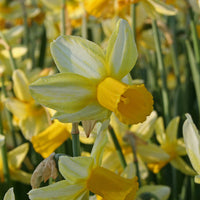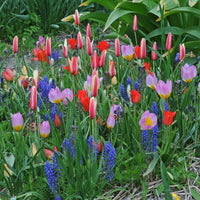Planting flower bulbs , now (autumn) is the time. Why should tulips that bloom in spring be planted in autumn? If they only bloom in April and May, you would think that you might as well plant them in March? But unfortunately that does not apply to tulips and other spring-flowering flower bulbs.
The best way to answer this question is to go back to the areas where the tulip originally comes from: the Middle East. Countries such as Afghanistan, Iran, Turkmenistan, Kazakhstan and also the east of Turkey are home to the tulip. In fact, if you draw a wide circle around the Caspian Sea, you will have the area where the tulip originally comes from for the most part. This is generally an area where it is bone dry in the summer and often very warm, in short, quite difficult conditions for most plants to live in.
The tulip has solved the problem of this difficult period by creating a reserve of food (the tulip bulb ) and by going into complete rest in the summer, during the heat. As soon as the first rain falls in the autumn, the tulip bulb makes roots, preferably as many as possible because the more roots the tulip has, the faster it can grow in the spring and the bigger the tulip becomes.
The tulip also likes to start making roots early because in the areas where it originally comes from it can be very cold in the winter. And once the tulip is in frozen ground or the temperature is just above zero then the root growth can stop. The winter period with all its cold is also important for the tulip bulb. The starch is now converted into sugars that can be absorbed by the plant and that are needed in the spring to quickly develop a full-fledged tulip plant.
The answer to the question “why should a tulip be planted in the fall” is: firstly, because the tulip needs the fall to develop roots that are needed for rapid growth in the spring.
Secondly, she needs the cold period to convert her food supply, the starch, into absorbable sugars. So if you plant a tulip in March, little will come of it. Of course, the tulip will try to squeeze out a flower because Mother Nature's survival instinct is great, but she will barely grow to 10 centimetres high and the crumpled flower will not last three days because she gets too little water because there are too few roots and sugars.
This is quite a story to point out that autumn is the time to plant tulips and various other spring-flowering bulbs. Because for other spring-flowering bulbs, the same story applies, in broad terms. The origin areas of the various types of bulbs are often different, but they all need roots and sugars to come into bloom in the spring, often as quickly as possible.
A nice detail is that the success of the spring flowering bulb that occurs in the wild is partly due to its early flowering. In early spring there is still little competition from other flowering flowers, which makes their flowers very popular with bees and other insects.













 Deutsch
Deutsch English
English
